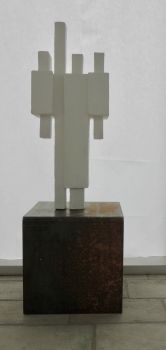"A box of building blocks unpacked with ingenuity" by Bert Kuipers Kunsthandel
I never noticed it before when I was cycling along the Leidsebosje… Amsterdam's first abstract sculpture ‘Horizontal Composition’ made by Henk Zweerus (1920-2005) in 1957. My attention was always drawn to a so-called ‘wild sculpture’, the blue Boomzagertje (Sawyer) on a tree branch. 'Wild' because it was placed as 'urban art' without the local goverment's permission and made by an anonymous artist. It had the 'classic' representation of a male figure seated on a branch while he is cutting of the branch he is sitting. But the sandstone sculpture displayed not far from this old sycamore is much more interesting But I didn’t know that yet. Today the sculpture is still there – a little bit as an orphan work but still present, while the sawyer fell of his tree and disapeared.
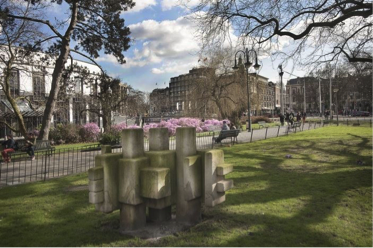
'Horizontale Compositie' by Henk Zweerus along the Leidsebosje, Amsterdam
I have never noticed the statue in front of the Amsterdam Lyceum on the Valeriusplein placed in 1960. Thirty years later I saw it for the first time. From a distance you are struck by the beautifully composed ‘Vertical structure’. Against the background with houses, trees and city bustle the sculpture shows the intensity, systematic approach and perfectionism of the artist. The pillar is not made out of natural stone but of a concrete which was cast in a mold. This abstract totem is made in a period in which Zweerus made his fist drawings for his series which he in the 1960s called 'statuettes'.
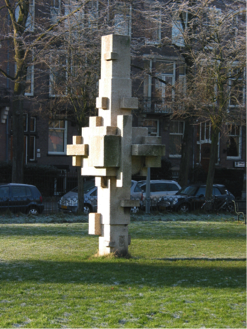
'Verticale structuur' by Henk Zweerus on the Valeriusplein, Amsterdam
Although, after the war, more and more commissions for monuments in the public spaces of Dutch cities were given, the sculptor Zweerus didn’t receive that much assignments. After his academic time he decided to work no longer on the model and nature. To earn his living he makes drawings with the artist Constant of the Canadian soldiers who frequented the cafés of Amsterdam after the war. It was also Constant who brought him into contact with Cobra artist's Karel Appel and Corneille. But although the principles of the movement fascinate him, he never became a real Cobra man. He remains, however, part of his Bergen friends, which among others, include Friso ten Holt, Jaap Min, Constant and Gerrit and David Kouwenaar.
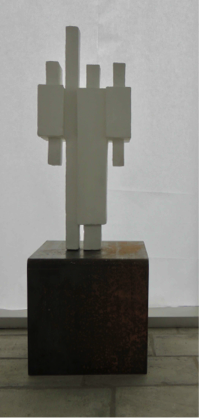
'Statuette' by Henk Zweerus available at Kunsthandel Bert Kuipers
Zweerus financial situation improves when he is asked to become a teacher at the newly established AKI in Enschede. From 1950 to 1955 he is a lecturer of 'vormstudies’ in primitive housing circumstances. The later ‘city sculptor of Enschede’, Gooitzen de Jong, is one of his students. Together with his fellow lecturers Aldo van Eyck, Joop Hardy and Wim Brusse, he travels to the textile city once a week. In 1954 he made the wall sculpture 'Looking and listening' for the new theater in Enschede. The statue is exhibited, rescued from the bronze kiln and after some wanderings, on a wall in the sculpture garden of Castle ‘t Nijenhuis near Heino, nowadays a part of the Museum De Fundatie in Zwolle.
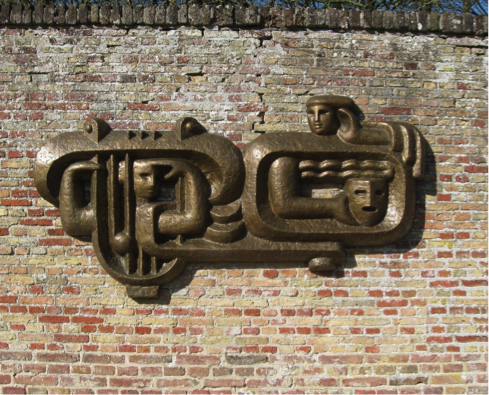
'Looking and listening' at Museum De Fundatie, 't Nijenhuis near Heino
Zweerus' educational career continues through the IvKNO, the later Rietveld Academy, to Delft University of Technology, where he was a lecturer in ‘vormstudies’ at the Department of Architecture for more than twenty years. Well-known architects such as Carl Weeber, Jan Benthem and Pi de Bruijn, who supervised the reconstruction of Roombeek in Enschede after the fireworks disaster in 2000, are students from Zweerus. Weeber, who according to Pi de Bruijn always got high marks, remembers: “Zweerus was frugal with words, that worked enchantingly. During the exercises in Delft he came out of his studio, walked around our works, put on his round black hat, measured his proportions with his hands and fingers, tapped the weakest part with his index finger, nodded and walked on. For us enough to see where the exact pain was."
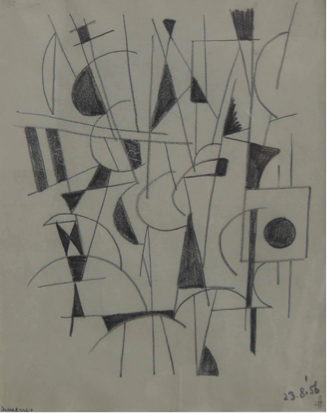
Drawing 1956
The permanent appointment, sealed by royal decree, enables Zweerus to work on a serial 'rectangular form research' every day in his own studio that is close to the classrooms. Sketches he made in his Amsterdam period and that form the basis of the sculptures on the Valeriusplein and in the Leidsebosje serve as the starting point for this research, which will last ten years. “An real obsession!”, according to one of his colleagues from Delft.
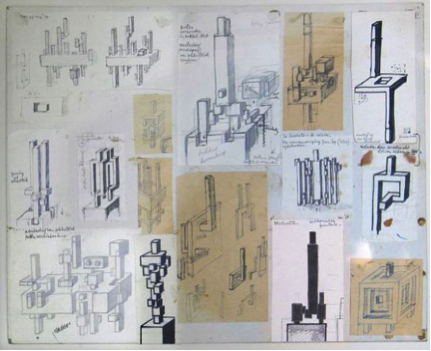
Sketches by Henk Zweerus
On his own and completely detached from the Liga Nieuw Beelden, Constant and his Nieuw Babylon, to Joost Baljeu and André Volten with their Style-derived constructivism and other cubistic space explorations, Zweerus tries to find a synthesis in his works like his master Bronner did with sculpture and architecture. This materializes in more than seventy rhythmic variations in Keim paint coated concrete, composed according to idiosyncratic ordering
principles. According to his own words, he entered a path 'to explore an area aside from the main traffic'. The architectural 'main traffic' in the Netherlands in this Post war period moves mainly in the regions of the soulless reconstruction, according to 'the act normal or down-to-earth' principle. 'Keine Experimente!', German statesman and chancellor Konrad Adenauer ordained.
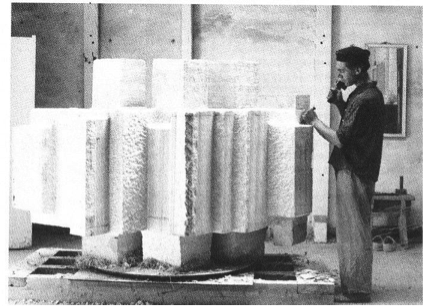
Henk Zweerus in his workshop in the late fifty's
When you are walking on the Zuidas in Amsterdam or coming from the Leuvehaven over the Erasmus Bridge in Rotterdam, or looking at the buildings in the rebuilt firework disaster area of Enschede, the architectonic tribute to the daring form studies of Henk Zweerus immediately shows. Did Henk Zweerus inspire for example Rem Koolhaas with his building in Rotterdam?
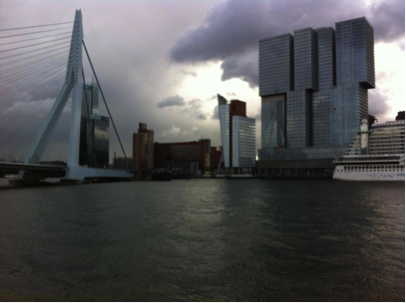
Rotterdam area around the Erasmus Bridge with De Rotterdam building by Rem Koolhaas
For years, the largest part of his 'statuettes' were stored in a basement of the former AKZO building in Arnhem. Though some of these statuettes are hidden in scrub foliage in gardens of museums, such as in museum Kranenbugh in Bergen elswere in the country, can be noticed by those who have an eye for it. Six of these have recently been exhibited in the Doorwerth Castle.
Twenty of these concrete statues are now composed to two little Manhattens, small conglomerates of eighty centimeters tall skyscrapers. This results in a rhythmic ornamental design, both per individual piece and per number together.
This result out of a box of building blocks unpacked with ingenuity, together with the architectural sketches and a selection from the thousands of drawings (including a tower of Babel of six meters high that Zweerus made in his later years) can be seen and purchased at Bert Kuipers Kunsthandel at the Lonnekerspoorlaan 104 in Roombeek and at Van Jeugd Architects, Nieuwe Schoolweg 4 in Enschede. The drawings and gouaches that have never been exhibited show that Henk Zweerus had an almost inexhaustible abstract idiom in his creations.
The exhibition is a reference to the architecture of today and to the images that are still in the public spaces. It shows that this artisanal and idiosyncratic artist was far ahead of his time. His work is the trait d'union between statue and building in the Netherlands.
For more, available works of Henk Zweerus, please have a look here at Gallerease
This artikel has been written by Bert Kuipers at Bert Kuipers Kunsthandel, curious to see more related modern artworks? Have a look at Bert Kuipers Kunsthandel


